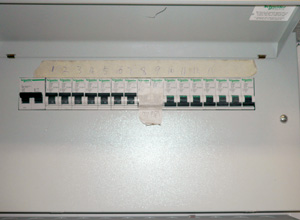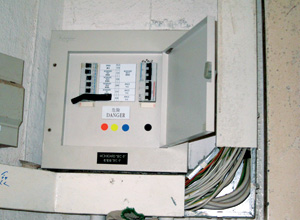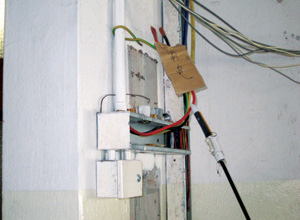
Feature Article
News-in-brief
Tidbits
Feature Article - Electrical Safety at Construction and Renovation Sites
There have been a number of fatal electrical incidents in Hong Kong in the recent past. Many of these incidents occurred at the construction or renovation sites. At the construction or renovation sites where installation work is underway, electrical workers often forget safety rules due to tight schedule or for the sake of temporary convenience, resulting in accidents.
For example, in an electrical incident which occurred on 14 July 2010 in Discovery Bay, Lantau Island, an electrical worker died from electrocution in a domestic unit under renovation. Investigation reveals that a registered electrical worker (REW) in the incident failed to ensure the compliance of safety precautions during the course of work to prevent the parts of a circuit which had not been completed nor properly terminated from being connected to the power supply. Consequently, a worker who was carrying out work under his supervision came into contact with the end of a live cable and was killed by electrocution. After the hearing held by the disciplinary tribunal formed under section 38 of the Electricity Ordinance (Cap. 406), the REW was convicted of contravening section 4(7) of the Electricity (Wiring) Regulations and was sentenced to a fine of $5,000 and suspension of his REW registration for six months.
Suspension of registration of an REW for contravention of the Electricity (Wiring) Regulations Code 4G(3) of the Code of practice for the Electricity (Wiring) Regulations stipulates that unless (a) the circuit and its final circuits, if any, are completed and properly terminated; or (b) the part(s) of the circuit or its final circuits which have not been completed, are disconnected or isolated with its associated isolating devices locked off, temporary or permanent supply should not be connected to a circuit.
Many people wrongly assume that by merely wrapping the cable ends with insulating tape (commonly known as cable tape), the requirement for "properly terminating" the circuit is already complied with. As a matter of fact, this is not a proper arrangement because the insulating tape wrapping the cable may become loose and come off, exposing the cable's live conductor. Furthermore, other workers at the site may pull off the insulating tape, without knowing whether the circuit concerned is live or not, and get an electric shock. The proper practice is not to connect the circuit to the power supply before it is set up. In case the work schedule requires that power supply be connected to the circuit, the power supply switch should be turned off and locked up to prevent anyone from turning on the power inadvertently.
Improper arrangement of wrapping the cable connected to the power supply with insulating tape
In regard to locking off the switch, the requirement that circuit breakers or isolating devices of larger rating be locked off is generally met with the relevant physical arrangements being made accordingly. However, this is not the case for miniature circuit-breakers. Electrical workers frequently consider a miniature circuit-breaker already locked off after covering the surface of the miniature circuit-breaker with tape, and/ or putting a notice to that effect on the tape. But this is absolutely not enough to prevent the others from turning on the miniature circuit-breaker, and it therefore is not a proper locking arrangement. Electrical workers should lock off the miniature circuit-breaker by using a proper locking device, and the key should be kept by the responsible registered electrical worker. There are various lock models suitable for locking off miniature circuit-breakers currently available in the market for the electrical trade. Registered electrical contractors and registered electrical workers should use these types of locks properly. If the miniature circuit-breaker cannot be locked off in practice, the circuit should not be connected to the miniature circuit-breaker.


It is inappropriate to only cover the miniature circuit-breaker with tape
As it gets close to the final phase of electrical installation work in the site, electrical workers have to be extra careful while carrying out the work because part of the circuit may already be energised. Before commencing work, the circuit concerned must be isolated. Electrical workers should commence work only after making sure that the circuit has already been de-energised by using a recognised voltage indicator.
In addition, Code 26K of the Code of Practice for the Electricity (Wiring) Regulations stipulates that the design and installation of temporary supply installation for construction and demolition sites or repair and testing purposes should be arranged in accordance with the requirements of the Electricity (Wiring) Regulations on general permanent electrical installations. Moreover, the temporary supply installation concerned should be able to withstand particularly adverse conditions with relevant approval obtained from the electricity supplier.
Temporary lighting at the site which is connected to the mains supply system and accessible to the public should be operated at 110 volts obtained by use of an isolating transformer with centre tap of secondary winding earthed such that the normal voltage of circuit to earth does not exceed 55 volts.
As regards protection against earth leakage, the temporary supply installation should be protected by means of a Residual Current Device (RCD) at main intake position. The operating current of the RCD to be used should be such that when its value in amperes is multiplied by the earth fault loop impedance in ohms, the product does not exceed 25 volts. Circuits supplying socket outlet should be protected by RCD having a rated residual operating current not exceeding 30 mA. An earthing conductor should be used to connect the consumer's main earthing terminal to an effective earth electrode. A bond should also be provided between electricity supplier's metal sheath cable and consumer's main earthing terminal. The size of the earthing conductor should be in accordance with Code 11H and 11G(b) respectively.
An owner of the temporary installation should ensure that the electrical equipment and apparatus are maintained in a safe and proper working condition at all times. A registered electrical worker should be appointed to be responsible for the safety and any alteration and extension of the installation. The name, designation and contact telephone number of such person should be permanently displayed close to the main switch of the installation. Regular checks, maintenance, repair, extension and alteration of the installation should be recorded in a separate log book for inspection by EMSD and the electricity supplier.
News-in-brief 2 - Registered Electrical Workers and Contractors – Don't Miss the Deadline for Registration Renewal
The Electricity (Registration) Regulations stipulates that registered electrical workers (REWs) and contractors (RECs) should submit to EMSD applications for registration renewal at least 1 month in advance, but no more than 4 months before the expiry date of the current registration. REWs and RECs are reminded again to apply for renewal of registration within the above-mentioned period. Applications submitted after the expiry date of the current registration will be treated as new registration applications, and will be assessed in accordance with the statutory requirements of the day. These include requiring REWs to possess recognised academic qualifications in electrical engineering and electrical work experience. If the applicant does not possess the required academic qualifications and is thus considered to be unable to fulfil the relevant registration requirements, the application will be rejected regardless of the previous registration history of the applicant.
In applying for registration renewal, the applicant is required to submit the duly completed Form 8 together with a copy of HKID card and a colour passport photograph in plain white background, and pay the application fee. In addition, REWs are also required to have completed two modules of Continuing Professional Development training before submitting their renewal applications.
News-in-brief 3 - The Tenth Annual General Meeting cum Trade Seminar held by AQSIQ and EMSD on Cooperation Arrangement on Electrical and Mechanical Products Safety and Energy Efficiency
 The General Administration of Quality Supervision, Inspection and Quarantine (AQSIQ) and EMSD held the tenth annual general meeting on the Cooperation Arrangement on Electrical and Mechanical Products Safety and Energy Efficiency and related working group meetings and trade seminar in Hong Kong from 23 to 24 July this year.
The General Administration of Quality Supervision, Inspection and Quarantine (AQSIQ) and EMSD held the tenth annual general meeting on the Cooperation Arrangement on Electrical and Mechanical Products Safety and Energy Efficiency and related working group meetings and trade seminar in Hong Kong from 23 to 24 July this year.
AQSIQ was represented at the meeting by an 18-member delegation led by Mr. GAO Yuchao, Director General of the Shenzhen Entry-Exit Inspection and Quarantine Bureau. By our arrangements, members of the AQSIQ delegation not only attended the annual general meeting and the working group meetings, but also went on a tour of the electrical and mechanical facilities at the Kai Tak Cruise Terminal to learn more about the work on electrical and mechanical safety and energy efficiency in Hong Kong.
 During the meeting, representatives of both sides reported on and summed up the work and progress under the framework of the Cooperation Arrangement over the past year, as well as laying down the cooperation plan for the coming year. Looking back over the past year, the working groups were working closely on matters pertaining to electrical and mechanical products safety and energy efficiency. With close ties being maintained by both sides, the work plans were successfully taken forward and implemented. During the period, both sides were able to further strengthen market monitoring, including emergency handling and reporting, investigation and feedback on cases of unsafe and non-compliant products, etc. There has also been widened cooperation on technology exchange, personnel training and certification, with a number of technical seminars held. Through continuous communication and exchange, the safety and energy efficiency standards of the products in both the Mainland and Hong Kong markets were enhanced effectively.
During the meeting, representatives of both sides reported on and summed up the work and progress under the framework of the Cooperation Arrangement over the past year, as well as laying down the cooperation plan for the coming year. Looking back over the past year, the working groups were working closely on matters pertaining to electrical and mechanical products safety and energy efficiency. With close ties being maintained by both sides, the work plans were successfully taken forward and implemented. During the period, both sides were able to further strengthen market monitoring, including emergency handling and reporting, investigation and feedback on cases of unsafe and non-compliant products, etc. There has also been widened cooperation on technology exchange, personnel training and certification, with a number of technical seminars held. Through continuous communication and exchange, the safety and energy efficiency standards of the products in both the Mainland and Hong Kong markets were enhanced effectively.
The results achieved through ten years of cooperation have enabled consumers in both the Mainland and Hong Kong to enjoy benefits in terms of products safety and energy efficiency. A mutually beneficial and win-win situation has been brought about. It is hoped that both sides can continue to make dedicated and concerted efforts to promote electrical and mechanical products safety and energy efficiency in meeting the mutually set targets, and to actively explore new direction of cooperation.
Meanwhile, EMSD has also invited trade members from both Hong Kong and the Mainland to participate in the trade seminar for the working groups on electrical products, gas appliances, lifts and escalators and energy efficiency held at the Hong Kong Jockey Club. The seminar provided an occasion for trade members from both the Mainland and Hong Kong and the officers of AQSIQ and EMSD to familiarise with one another, and discussions were held on the regulatory work on electrical and mechanical products safety and energy efficiency in both the Mainland and Hong Kong, thereby establishing a communication link between the trades and relevant organisations of both sides.
The annual general meeting cum trade seminar was a great success. Thorough discussions and exchanges on topics of mutual interest were conducted, with consensus reached and expected results achieved. On the basis of the cooperation on different areas of electrical and mechanical products safety and energy efficiency development, the meeting further enhanced the effective communication channel that has been established, as well as deepening the mutual understanding between AQSIQ and EMSD. It is conducive to the creation of more new work items for achieving more comprehensive cooperation and results in the future.
Tidbit 1 - Safety Tips for Festival Lighting Chains
The Electrical Products (Safety) Regulation stipulates that household electrical products, including festival lighting chains, sold in Hong Kong should comply with recognised international safety standards such as IEC60335-2-20 or other equivalent safety standards. In general, electrical products like festival lighting chains should be labeled with information on their appropriate safety requirements, such as rated voltage and frequency, rated input (or current), manufacturer's name, product model number, double insulation symbol "回" for Class II electrical product, etc. In addition, they should have appropriate protection devices installed to protect the safety of consumers.
Electrical product suppliers should ensure that the products they supply are in compliance with the relevant safety requirements and are issued with "certificates of safety compliance" for inspection by EMSD. A "certificate of safety compliance" can either be a certificate issued by a recognised testing laboratory confirming that the electrical product has passed the compliance test for relevant international safety standards, or a declaration of conformity issued by the manufacturer certifying that the product is produced in accordance with the relevant international safety standards. Apart from conducting random checks from time to time on the household electrical products sold in the market and arranging for their testing, EMSD also carries out frequent surprise inspections of shops to ensure that the products on sale are safe and reliable and are issued with "certificates of safety compliance". Members of the public should take heed of the following when buying and using festival lighting chains:
- Choose and buy branded festival lighting chains from reputable stores.
- The construction should be of double or reinforced insulation design. In addition to appropriate markings on rated voltage, rated current/input power, rated frequency, the lighting chains should also be marked with the model number and manufacturer's name or trademark, and a "回" symbol.
- Only 3-rectangular-pin plugs to BS1363 or 3-round-pin plugs to BS546 should be used. Avoid using other types of plugs such as 2-pin plugs.
- To avoid danger, the lighting chains should not be installed in an outdoor environment arbitrarily unless they are specifically designed for such purpose.
- To install the lighting chains in accordance with the instruction manual. Do not overload.
- If the lighting chains have not been used for a prolonged period of time, they should be checked before use again. Make sure they are in normal condition prior to use.
- Sufficient space must be allowed around the lighting chains and the power supply for heat dissipation.
- Lighting chains should not be installed in a humid area, such as bathroom, balcony, etc., to avoid earth leakage.
- To ensure safety, switch off the power supply of the lighting chains before leaving home.
- In the event of abnormalities, such as strange noises and smells, or tripping for unknown reason, stop using and unplug the lighting chains immediately and arrange for checking by a qualified technician.
For enquires on electrical products safety, please call 1823 Citizen's Easy Link or email to info@emsd.gov.hk. You may also write to EMSD (address: 3 Kai Shing Street, Kowloon).
Tidbit 2 - Outstanding Registered Electrical Worker Awards Scheme 2013
 The written test in the first stage was held at Hong Kong Design Institute on the evening of 20 August.
The written test in the first stage was held at Hong Kong Design Institute on the evening of 20 August.
To continuously enhance the professionalism and safety standard of the electrical trade and to give commendation to electrical workers with outstanding performance, EMSD has again organised the "Outstanding Registered Electrical Worker Awards Scheme" in collaboration with trade associations. The scheme celebrates the achievement of distinguished trade practitioners and gives them an opportunity to share their daily work experience and insights with other trade members.
 In addition to testing registered electrical workers on their knowledge of electrical safety, the scheme also tests their professional skills. Participants are required to attend an interview and a trade test on their professional knowledge in the second stage after passing the written test in the first stage. In addition to Gold Prize, Silver Prize, Bronze Prize and Merit Prize, the scheme has two newly-created awards this year, namely the Best Professionalism Award and the Best Safety Award.
In addition to testing registered electrical workers on their knowledge of electrical safety, the scheme also tests their professional skills. Participants are required to attend an interview and a trade test on their professional knowledge in the second stage after passing the written test in the first stage. In addition to Gold Prize, Silver Prize, Bronze Prize and Merit Prize, the scheme has two newly-created awards this year, namely the Best Professionalism Award and the Best Safety Award.
Selection work for the awards was completed in mid-October this year. The results are available on the EMSD website, and the winners will be interviewed by the Electricity News. Please watch out for the next issue to know more about the work experience and insights of the winners.
News-in-brief 5 - 電力安全考考你
1.
|
A consumer installation must be provided with a main switch or circuit breaker, the main function of which is:
|
| |
- Protection against overcurrent of the power company's equipment
- Protection against earth leakage
- For isolating and turning on/shutting off of power supply
- None of the above
|
2.
|
The characteristics of a protection device against circuit overload should satisfy one or more of the following requirements:
|
| |
- The nominal current or current setting of the protection device should not exceed the lowest of the current carrying capacities of any of the conductors in the circuit.
- The nominal current or current setting of the protection device should exceed the lowest of the current carrying capacities of any of the conductors in the circuit.
- The current causing effective operation of the protection device does not exceed 1.45 times the lowest of the current carrying capacities of any of the conductors of the circuit..45倍
- i
- ii
- i, iii
- ii, iii
|
3.
|
A minimum clearance space of ______ mm should be provided for the full width and in front of all low voltage switchgear having a rating not exceeding 100 amperes (A).
|
| |
- 600
- 800
- 900(A)插座
- 1000
|
4.
|
Live conductors should be completely covered with insulation which:
|
| |
- can withstand the mechanical and electrical stresses to which it may be subjected in service
- can withstand the thermal and chemical stresses to which it may be subjected in service
- can be removed without causing damage
- i, ii
- i, iii
- ii, iii
- all of the above
|
5.
|
According to the Electricity Ordinance, "low voltage" means, between conductors, voltage normally exceeding extra low voltage of 50 volts root mean square alternating current but normally not exceeding ______ volts root mean square alternating current.
|
| |
- 380
- 600
- 1000
- 11000
|
( Ans : 1c, 2c, 3a, 4a, 5c )
Feedback
We look forward to receiving your valuable feedback about this newsletter for continuous improvement. Please complete the feedback form, below and return it to our Electricity Legislation Division by post, fax or e-mail on or before 31 Dec 2013 (please refer to the contact information at the bottom of this page).
Contact Information
Electricity Legislation Division, EMSD, 3 Kai Shing Street, Kowloon, Hong Kong
1823
2896 4929
info@emsd.gov.hk
23rd Issue (December 2013)













 In addition to testing registered electrical workers on their knowledge of electrical safety, the scheme also tests their professional skills. Participants are required to attend an interview and a trade test on their professional knowledge in the second stage after passing the written test in the first stage. In addition to Gold Prize, Silver Prize, Bronze Prize and Merit Prize, the scheme has two newly-created awards this year, namely the Best Professionalism Award and the Best Safety Award.
In addition to testing registered electrical workers on their knowledge of electrical safety, the scheme also tests their professional skills. Participants are required to attend an interview and a trade test on their professional knowledge in the second stage after passing the written test in the first stage. In addition to Gold Prize, Silver Prize, Bronze Prize and Merit Prize, the scheme has two newly-created awards this year, namely the Best Professionalism Award and the Best Safety Award.